MakerGirl Uses 3D Printing to Get Girls Interested in STEM
October 30, 2015
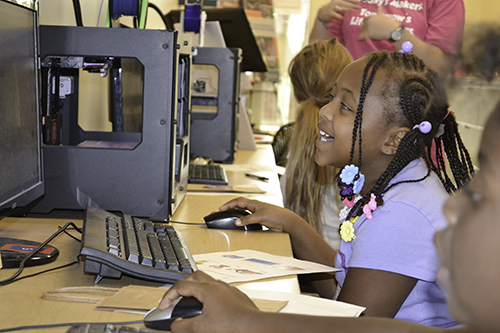
Girls from a local girl scout troop enjoy using Tinker CAD to make their 3D designs.
Local girls who participate in the MakerGirl after-school program are doing more than just 3D printing objects they’ve designed. Little do they know it, but while sitting there tinkering on kid-friendly Tinker CAD (Computer-Aided Design) software, they’re learning to think like the big girls in STEM disciplines, such as engineering, do. And if MakerGirl has its intended impact, the fun, creative STEM-related activities will, like the Pied Piper, "introduce girls to the magic of science" and lead them straight into the STEM pipeline.
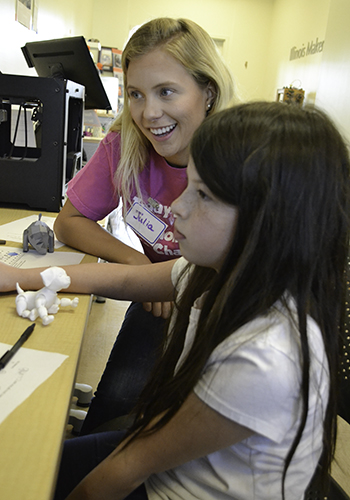
Julia Haried (left) helps a young MakerGirl with her 3D design.
Held in MakerLab on the third floor of Illinois’ BIF (Business Instructional Facility) on Mondays, Wednesdays, and some Saturdays, the program targets 7–10-yr-old girls. After a short presentation about the theme and related scientific principles, the girls use Tinker CAD (a free, web-based software program for kids), to make 3D designs, which they then fabricate via 3D printers.
“It gives them the reasoning behind CADing in terms of understanding spatial reasoning and problem solving within a 3D realm,” reports Charlotte Israel, a sophomore in Material Science and Engineering.
Co-founder Julia Haried explains why the program is targeting younger girls.
“We started MakerGirl because we wanted to make a difference in women and girls' lives, and this was a way that we could actually do something for the younger generation. Because we know that 7–10 year olds, this is a critical age for them, when they start saying, ‘No.’ We want girls of today and tomorrow to be unstoppable forces that say, ‘Yes!’ to the challenges of the future.”

Caitlyn Deegan, a sophomore in Materials Science and Engineering, helps a young MakerGirl with her design.
According to Stephanie Hein, a senior in Molecular and Cellular Biology and Chemistry, “The purpose of MakerGirl is to get girls to become active in STEM.” She then cites a current lack of girls in STEM fields at every level—from engineering classes here on campus to the CEOs of large tech companies.
“So our goal is to introduce STEM fields through 3D printing workshops,” she continues, “just to show the young girls in our community how they can become involved.”
Hein says that this semester, the program is trying to link areas of life like fashion and sports to 3D printing: “They can love fashion, but they can also love science, and there’s a way to combine them and do both.”
So in the Passion for Fashion session, girls designed and printed outfits for a little paper doll, and could even take the same session over again to make additional outfits for their doll.
The idea behind the Geared for Greatness session was “to introduce the girls to the ideas of cause and effect,” explains Israel. Here’s the scenario: two gears were placed far away from each other on a peg board.
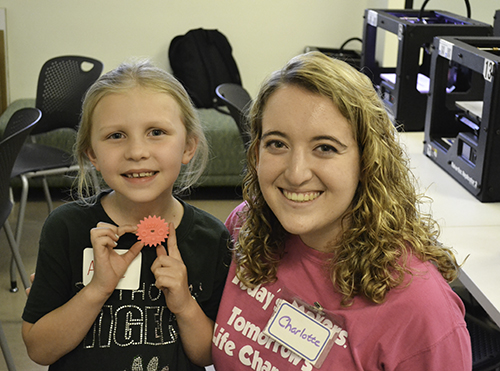
Charlotte Israel (right) with Addie, one of the MakerGirl regulars, who is showing off the gear she designed then 3D printed.
“How are we going to solve this?” they then asked the girls. “You spin one, and the other one doesn’t turn. How are we going to solve this?” Each girl then made her own gear and put it on the board, thus contributing to making the final gear move.
In STEM in Sports, the girls were given examples of how 3D printing can relate to sports or help athletes, and then 3-D printed sports-related items: parts of NIKE cleats, wheelchairs for wheel chair basketball, or prosthetics (legs) for paralympic athletes.
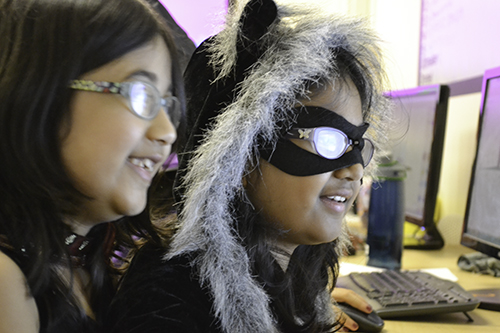
Two sisters dressed in Halloween costumes enjoy making their design during the "Sweet STEM" session.
Creating with Chemistry introduced girls to basic chemistry concepts using the states of matter: solid, liquid, and gas and differences in the molecular density of 3-D printing plastic as a liquid (when it prints) vs. as a solid (when it solidifies causing the object to become solid).
In the Sweet STEM session, the girls, dressed up in their Halloween costumes, designed and printed items that make the world a sweeter place.
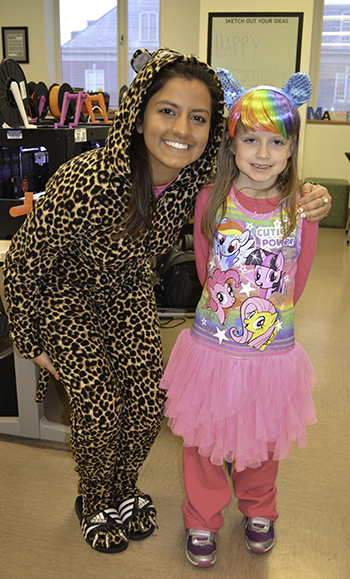
Sona Kaul, a junior in Industrial and Enterprise Systems Engineering (left) and a young MakerGirl at the Sweet STEM session.
A couple of MakerGirl sessions feature local non-profit organizations. For the Camp Kesem session in October, a representative from the organization explained how their program helps kids in Champaign-Urbana, then the girls 3D printed keychains the organization could give out as promotional items. A session featuring another local partner, Big Brothers, Big Sisters, is scheduled for November. Also, two Saturday sessions in October featured the That’s What She Said organization and Nail Bot technology.
Co-founders Elizabeth Engele and Julia Haried began MakerGirl in fall 2014; they came up with the idea in a social entrepreneurship class they took together then held their first pilot session that semester. Then in spring 2015, around 80 girls participated in the program. Although the two graduated in spring 2015 (Haried, however, is still on campus getting a Master’s in Accounting), they passed the baton on to a number of students who caught the vision and have run with it.
For example, Stephanie Hein began working with MakerGirl in March of 2015. Charlotte Israel joined in May of 2015, specifically for the summer program. Currently the innovation director, she’s also a fellow with I-Venture Accelerator, which is providing funding. Over summer 2015, Israel and Caitlyn Deegan dedicated 8–9 weeks solely to MakerGirl, when about 300 girls went through the program.
The current MakerGirl team at Illinois is comprised of sixteen students (fifteen girls and, yes, one guy) representing a myriad of disciplines: accounting, business, engineering, CS, marketing, and advertising. Israel reports that they're trying to get more people involved from engineering and education as well.
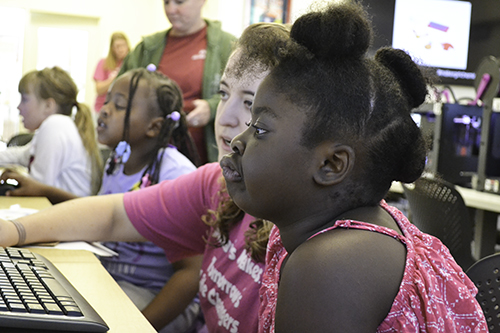
Above: A girl scout watches as Charlotte Israel (center) explains how to use TinkerCAD during Creating with Chemistry.
Below: Manisha Singh (center), a senior in Applied Math and Economics, helps one of the girls, Sarah, with her design.
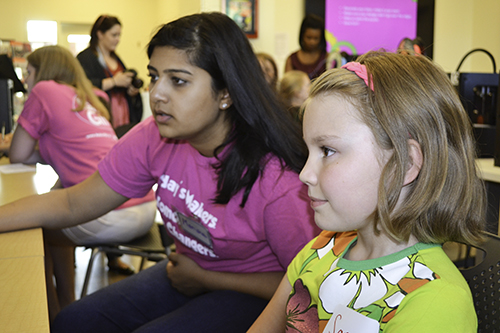
How do they recruit girls to the program? To give as many local girls as possible the chance to be involved, the team distributed 1500 flyers to local elementary schools, YMCAs, and at the Orpheum Children’s Museum (where they have also held sessions). They also contacted the Girl Scouts, and report sending out lots of emails.
Haried indicates that MakerGirl is also looking at expanding to southern Illinois, where they hope to involve Southern Illinois University students, and also hopes to expand north to Chicago, where the program won’t be directly affiliated with a specific university. However, they hope to get women from UIC and IIT to help run it.
To determine whether MakerGirl is having the impact they intend, leaders administer surveys both before and after sessions. They ask questions like, “What do you think about science and technology? Do you like it? What do you want to be when you grow up? What does technology mean?” And based on responses, the program seems to be working. “Their answers have been improving,” admits Israel. “They like Science and Technology more; they rate it higher on the scale on 1–5.”
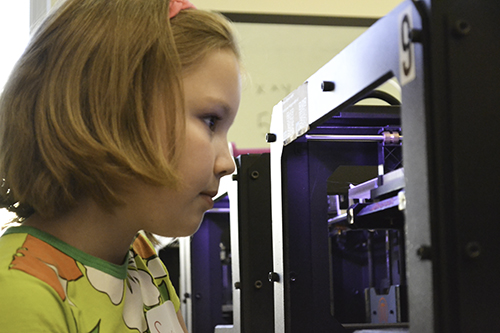
Sarah patiently watches while the gear she designed 3D prints.
They also have annecdotal evidence that MakerGirl has been effective. For instance, one little girl attends every session. Her mother indicates that her daughter is extremely interested in STEM: “She brings home forms/flyers from school all the time, and says, ‘Sign me up! Sign me up!’” Mom confirms that MakerGirl is filling a particular, much-needed niche: “We jumped on the opportunity to have her do some of these classes…She’s really interested in science and math, and you just don’t find a whole lot of programs that are based around science and math for girls.”
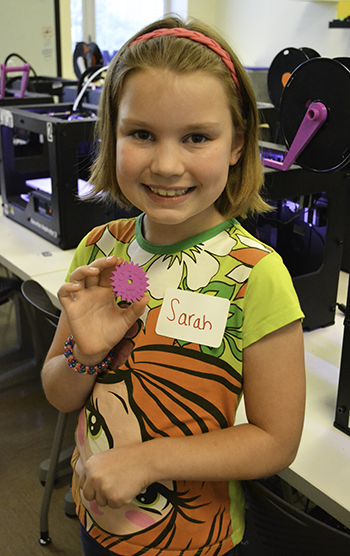
Sarah shows off her finished product.
Israel shares an anecdote about a little girl she interacted with over the summer. Upon noticing that only one girl signed up for a session, she emailed the girl’s mother and said, “If she wants to switch, that’s fine, if she might not be comfortable being alone.” The mom responded, “No, she’ll be great; it’s fine!” “This kid comes,” Israel continues, “she has a journal filled with her inventions, and then she wanted to print out all of her inventions. It was so cute! She printed out four things because she had the entire hour and a half to herself, and it was great!”
She also delightedly reports, “There’s actually this one girl who now consistently, when asked ‘What do you want to be?’ she’s like, ‘I want to be a MakerGirl.’ Every time! She just writes that down.”
Why do busy Illinois students make time for MakerGirl? Israel, for instance, hopes to get more girls into STEM. While she's invested in women’s education partly because she went to an all-girls school growing up and didn’t think there were any other types, she also admits that she had begun to notice during summer programs she would take, that girls didn’t necessarily speak up, or that few or even no girls would take the math or science classes.
“So I suddenly became aware that, even within my school, there weren’t that many girls who liked science. So I wanted to spread that love of science I always had as a kid…to introduce kids to the magic of science. Because when you’re a kid, it’s basically magic! So I always liked seeing that spark in the kids, ‘This is amazing! I want to figure out how this works.’”
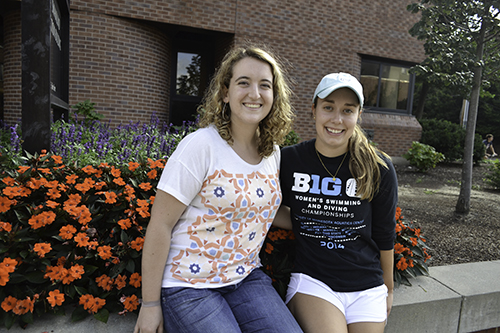
Left to right: Charlotte Israel, a sophomore in Material Science and Engineering, and Stephanie Hein, a senior in Molecular and Cellular Biology and Chemistry
Hein indicates that she’d like to give today’s girls some opportunities she missed as a kid: “I would have loved to do something like this as a kid. I liked playing with Legos and Thomas the Tank Engine and building stuff like that, but I never got to do anything like MakerGirl. I would have loved to 3-D print as a kid. I love working with kids too, and I love science, obviously, because I’m majoring in it. So combining the two is really fun for me, because it’s science and kids together, which are the two things that I love. That’s why I like doing it.”
Based on some of the conversations they’ve had with the girls, Hein and Israel believe they have encountered some future engineers. Hein says, “I remember one girl just loved talking to me about how she did a coding program after school, and she was just all excited, and she talked to me for 10 minutes about how she learned how to code, and it’s after school every day, and she loves it.”
“There've been a couple girls who have come in with similar interests,” she continues, “and just by talking to them, you can tell they really love this, and I can see them doing it.”
Author/Photographer: Elizabeth Innes, Communications Specialist, I-STEM Education Initiative
More: K-6 Outreach , Maker Girl, Women in STEM, 2015
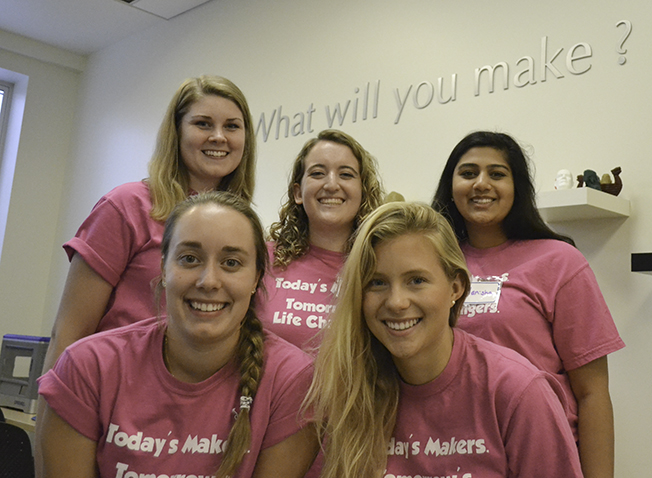
Left to right: Maker Girls Caitlyn Deegan, Stephanie Hein, Charlotte Israel, Julia Haried, and Manisha Singh.













.jpg)
















